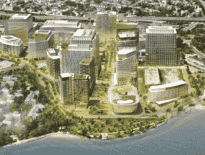Mark Pasnik
Principal, OverUnder
Age: 50
Industry experience: 25 years
Mark Pasnik looks to Boston’s bold design choices of the past for guidance shaping the future face of the city. Pasnik is the author of “Heroic: Concrete Architecture and the New Boston,” which examines the role of modernist designs in the heyday of the city’s urban renewal era. A principal at Boston-based architecture firm OverUnder, Pasnik co-founded the Pinkcomma gallery in South End, which spotlights innovative designs by emerging architects, and is a member of an advisory committee on the state’s plans to redevelop the historically-protected Charles F. Hurley office building in West End.
Q: The Boston Art Commission voted to remove the Emancipation statue in Park Square because of racial sensitivities. As commission chair, is the group undertaking a comprehensive review of the city’s public art?
A: In 2018, we initiated a process to study our collection and racial issues in the city of Boston. There was a report, but we didn’t fully deliver on it. With the Black Lives Matter movement and George Floyd’s death, it returned to the attention of the commission that we needed to address this, and the Emancipation statute would be the first of these. Around the same time, an artist, Tory Bullock, circulated a petition which garnered a lot of attention and made us and the city realize this was an important piece for evaluation. In many cities, people were tearing down statues on their own. In Boston, it was remarkable how high a level of discussion there was among the public. And for me, it was a moment of civic pride. Not everybody agreed with the final decision, but I was impressed by the passion and thoughtfulness of the discussion.
Q: How much risk-taking is there in Boston architecture and what are the factors that influence that?
A: Boston has tended to be conventional, especially in its development community. We’re not very risk-taking. Some of the best work I’m seeing is coming from the city itself: things like the [Bruce C.] Bolling building and the Boston Public Library renovations. [MIT Investment Management Co.] has done some great projects along Main Street in Cambridge, and there are smaller, nimbler projects such as Howeler + Yoon’s 212 Stuart St. Some of the smaller developers are doing unique work. Many of the bigger developers tend to focus on very large corporate offices and they are producing not bad work, but it’s not as innovative as we could be.
Q: How does the role of the Boston Civic Design Commission influence the look and approach to Boston’s built environment?
A: I think [the commission] needs to be strengthened, not weakened. There are great people on that commission and they are top-tier architects with a sophisticated sense of design. They help shape some of the weak projects into better projects. I know there’s a financial issue and certainly developers, if they didn’t have this control point, might not pay as much attention to design as they do. I just wish it were a stronger process. It’s all advisory and [the commission’ can be overruled. A similar commission was set up in the 1960s, and there’s all of these stories that you had to show your ‘A’ game by the time you got to that commission, because everybody lived in fear they would get rejected by some of the architects.
Q: You received national recognition in November as one of Out magazine’s top influencers of 2020. How would you rate the local architecture community’s support of the LGBTQ community?
A: There’s a pretty good history locally here of supporting the LGBTQ community in architecture, and that’s in the nature of being in a city like Boston. Boston was in the center of the marriage equality debate in the early 2000s, and it has a long history of progressive values. Recognition of the trans community is an area that still needs further growth, and there’s a bigger issue which is lack of representation by people of color and lack of equal representation of women, especially in senior positions. That’s not unique to Boston, but it is a crisis of architecture because there hasn’t been sufficient engagement with young people considering the field. There has to be a better gateway. The BSA is reaching to communities to make entering the profession less difficult.
Q: As the author of a book on local modernist designs, what’s important to know about the role of modernist architecture in Boston?
A: Chris Grimley and I did an exhibition we called “Heroic” in 2007 in one of the first exhibits at our gallery, and that launched our interest in Boston’s concrete modern period. Since then I’ve been very involved, including the conservation management plan for Boston City Hall. It’s looking at future policies that will help the building adapt to change, and what should be preserved as-is. OverUnder is doing the environemntal graphics for the Ciyt Hall Plaza projects as well, and I was historical adviser to that team. Now my design studios at Wentworth are working with the mayor’s office and Boston Public Schools to examine possible futures for the O’Bryant School campus in Madison Park.
- John Hancock Tower,by Henry N. Cobb of I. M. Pei and Partners (1976)
- Boston City Hall,byKallmann, McKinnell and Knowles (1969)
- MIT Chapel,byEero Saarinen (1955)
- Government Service Center,by Paul Rudolph (1971)
- Christian Science Center,byAraldo Cossutta of I. M. Pei and Partners (1973)




 |
| 

